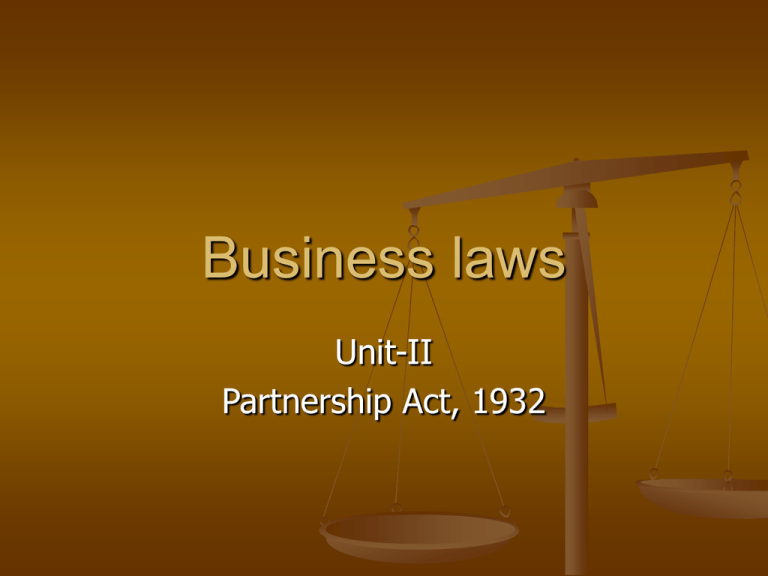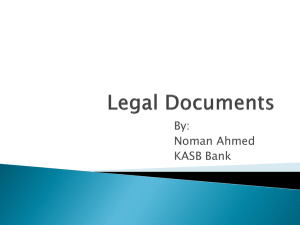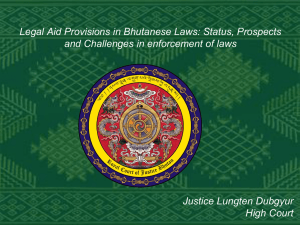Partnership Act 1932
advertisement

Business laws Unit-II Partnership Act, 1932 Introduction to Topic One of the forms in which business can be carried on is ‘partnership’, where two or more persons join together to form the partnership and run the business. In order to govern and guide partnership, the Indian Partnership Act, 1932 was enacted. Since public at large would be dealing with the partnership as customers, suppliers, creditors, lendors, employees or any other capacity, it is also very important for them to know the legal consequences of their transactions and other actions in relation with the partnership. Features of Partnership Act, 1932 Indian Partnership Act, 1932 is a Central Act. (made by Parliament This Act deals with special type of contract.( contract of partnership) Provisions regarding contract of partnership were earlier contained in the Indian Contract Act, 1872. This Act extends to the whole of India except the state of Jammu and Kashmir. This Act came in to force on 1.10.1932, except section 69 which came into force on the 1st Day of October, 1933. Meaning &Definition of ‘Partnership’ Section 4 of the Partnership Act, 1932 defines the term ‘Partnership’ as under: ‘’PARTNERSHIP IS THE RELATION BETWEEN TWO OR MORE PERSONS WHO HAVE AGREED TO SHARE THE PROFITS OF A BUSINESS CARRIED ON BY ALL OR ANY OF THEM ACTING FOR ALL’’. Thus, Partnership is the name of legal relationship between/among persons who have entered in to the contract. Meaning of ‘Partner’ ‘Firm’ and ‘Firm Name’ Section 4 of Indian Partnership Act, 1932 provides that: Persons who have agreed into partnership with one another are called individually ‘PARTNERS’ and collectively ‘FIRM’ and the name under which their business is carried on is called the ‘FIRM NAME’ “Partnership is thus Invisibility which binds the partners together and firm is the visible form of those partners who are thus bound together”. Maximum Limit on Number of Partners Section 11 Companies Act provides that the maximum no. of persons, a firm can have: In case of partnership firm carrying on a banking business 10 In case of partnership firm carrying on any other business 20 If the number of partners exceeds the aforesaid limit, the partnership firm becomes an illegal association. If an association of persons or firm having members or partners exceeding the Above limit will not be an illegal association if that firm’s objective is not to earn profit. Essential elements of Partnership Two or more persons Sharing of profit An agreement Mutual agency Business For forming a partnership the above elements should be present. Though each element is important, ‘Mutual Agency is the conclusive proof For explanation go through the next slides: Nature of Partnership A partnership firm is not a person in the eyes of Law (except for the purpose of taxation [sec.2 (31)] ). It has no separate legal entity (like company) apart from the partners constituting it. [Malabar Fisheries Co. v CIT] Further Section 5 of the Act provides that partnership arises from contract and not from status (like HUF). Solve the Case There are two firms namely M/s PQR and M/s ABC. These two firms are contemplating to form a new firm. Can they do so? Answer: ? Real test of partnership [Sec. 6] The true test of partnership is the existence of ‘Mutual Agency’ relationship, i.e. the capacity of a partner to bind other partners by his acts done in firm’s name and be bound by the acts of other partners. Sharing of profit is an essential element of partnership but it is not a conclusive proof of partnership. Sharing of profit is Prima facie evidence. Thus partnership can be presumed when a.There is an agreement to share the profits of business and b.The business is carried on by all or by any of them acting for all. Contd. Contd. The relation among partners can be ascertained as under: a.If there is an express contract. The real relation is ascertained from the partnership contract. b.If there is no express The real relation is ascertained contract from all the relevant factors such as contract of parties, books of account, statement of employees etc. Meaning of Mutual Agency Mutual agency refers to the relationship of principal and agent Among partners Example in case of firm of A,B and C When A acts A- Agent B and C- Principal When B acts B- Agent A and C- Principal When C acts C- Agent A and B- Principal Partnership does not exist though there is profit sharing. In the following cases there is profit sharing but partnership does not exist just because of lack of Mutual Agency: 1. Joint owners of some property sharing profits or gross returns arising from the property. [explanation I to Sec. 6] Example: X and Y jointly purchased a building and contributed capital Equally to convert the building into a hotel. They let it out on a rent Of Rs. 1,00,000 per annum and share the rental income equally. Leading case: Govind V. Maga Contd. Contd. A lender of a firm (who has lent money) who receives a share of profit. (Mollow March V. The court of Wards) A widow or child of a deceased partner who receives a share of profits. (I. T. Commissioner V. Keshamal Keshardeo) A servant (a manager) or an agent who receives a share of profit as part of his remuneration. (Munshi Abdul Latif V. Gopeshwar Chatoraj) A person who receives a share of profit in consideration of sale of business or goodwill of the business. A member of a Hindu Undivided Family carrying on family business. [Sec. 5] Burmese Buddhist husband and wife carrying on business.[Sec. 5] Characteristics of Partnership A partnership firm has the following characteristics: 1. Two or more members 2. Unlimited liability 3. Voluntary registration 4. No separate legal existence 5. Restriction on transfer of interest: 6. Based on agreement 7. Partners are competent to contract 8. Partnership may be only for lawful business. Types of Partnership On the Basis of Duration Partnership at Will (Sec.7) Particular Partnership (Sec.8) Partnership at Will [Sec.7 read with Sec.43)] When there is no provision in partnership agreement (known as partnership Deed, if in writing) for: The duration of their partnership, or The determination of their partnership, then the partnership is called ‘Partnership at Will’. Special feature of ‘Partnership at will’ is that such firm may be dissolved by any partner by giving a notice in writing to all other partners of his intention to dissolve the firm The firm will be dissolved from that date which is mentioned in the notice as the date of dissolution and if no date is mentioned then from the date of communication of notice. Particular Partnership [sec. 8] When a partnership is formed for a Specific venture or undertaking, or Particular period (fixed term) then such partnership is called a ‘particular partnership’. Such partnership comes to an end on the completion of the venture or the expiry of time period. If such partnership is continued after the expiry of term or completion of venture, it is deemed to be a partnership at will. A particular partnership may be dissolved before the expiry of the term or completion of the venture only by the mutual consent of all the partners. Contd. Sec. 17 (b) of the Act provides that if a firm ,constituted for a fixed term, continues to carry on business after the expiry of that term, then the partnership will become partnership at will AND mutual rights and duties of partners will remain same as they were before the expiry. Advantages of Partnership Firm Easy to form: Like sole proprietorships, partnership businesses can be formed easily without any compulsory legal formalities. It is not necessary to get the firm registered. A simple agreement or partnership deed, either oral or in writing, is sufficient to create a partnership. Availability of large resources: Since two or more partners join hands to start a partnership business, it may be possible to pool together more resources as compared to a sole proprietorship. The partners can contribute more capital, more effort and more time for the business Contd. Advantages contd. Better decisions: The partners are the owners of the business. Each of them has equal right to participate in the management of the business. In case of any conflict, they can sit together to solve the problem. Since all partners participate in the decision-making process, there is less scope for reckless and hasty decisions. Flexibility in operations: A partnership firm is a flexible organization. At any time, the partners can decide to change the size or nature of the business or area of it’s operation. There is no need to follow any legal procedure. Only the consent of all the partners is required. contd. Contd. Sharing risks: In a partnership firm all the partners “share” the Benefits of specialization:Since all the partners are owners of the business risks. For example, if there are three partners and the firm makes a loss of Rs.12,000 in a particular period, then all partners may share it and the individual burden will be Rs.4000 only. Because of this, the partners may be encouraged to take up more risk and hence expand their business more. business, they can actively participate in every aspect of business as per their specialization, knowledge and experience. If you want to start a firm to provide legal consultancy to people, then one partner may deal with civil cases, one in criminal cases, and another in labor cases and so on as per the individual specialization. Similarly, two or more doctors of different specialization may start a clinic in partnership. Contd. Protection of interest of each partner: In a partnership firm, every partner has an equal say in decision making and the management of the business. If any decision goes against the interest of any partner, he can prevent the decision from being taken. In extreme cases an unsatisfied partner may withdraw from the business and can dissolve it. In such extreme cases the “partnership deed” is required. In absence of the partnership deed, no legal protection is given to the partners. Disadvantage of Partnership Firm Unlimited liability:All the partners are jointly liable for the debt of the firm. They can share the liability among themselves or any one can be asked to pay all the debts even from his personal properties depending on the arrangement made between the partners. Uncertain life:The partnership firm has no legal existence separate from it’s partners. It comes to an end with death, insolvency, incapacity or the retirement of a partner. Further, any unsatisfied or discontent partner can also give notice at any time for the dissolution of the partnership. No transferability of share:If you are a partner in any firm, you cannot transfer your share or part of the company to outsiders, without the consent of other partners. This creates inconvenience for the partner who wants to leave the firm or sell part of his share to others. Contd. Contd. Lack of harmony: In a partnership firm every partner has an equal right to participate in the management. Also, every partner can place his or her opinion or viewpoint before the management regarding any matter at any time. Because of this, sometimes there is a possibility of friction and discontent among the partners. Difference of opinion may lead to the end of the partnership and the business. Limited capital: Since the total number of partners cannot exceed 20, the capital to be raised is always limited. It may not be possible to start a very large business in partnership form. Partnership deed A partnership is formed by an agreement. This agreement may be in writing or oral.though the law does not expressly require that the partnership agreement should be in writing, it is desirable t o have it in writing in order to avo8id any dispute with regard to the terms of the partnership. The document which contains the term of a partnership as agreed among the partners is called “partnership deed”. The partnership Deed is to be duly stamped as per the Indian Stamp Act, and duly signed by all the partners. Contd. Contents of partnership Deed A partnership deed may contain any matter relating to the regulation of partnership but all provisions in the deed should be within the limits of Indian Partnership Act, 1932. However, A Partnership Deed should contain the following clause: Nature of business Duration of partnership Name of the firm Capital Share of partners in profits and losses Bank Account firm Books of account Powers of partners Retirement and expulsion of partners Death of partner Dissolution of firm Settlement of disputes
















